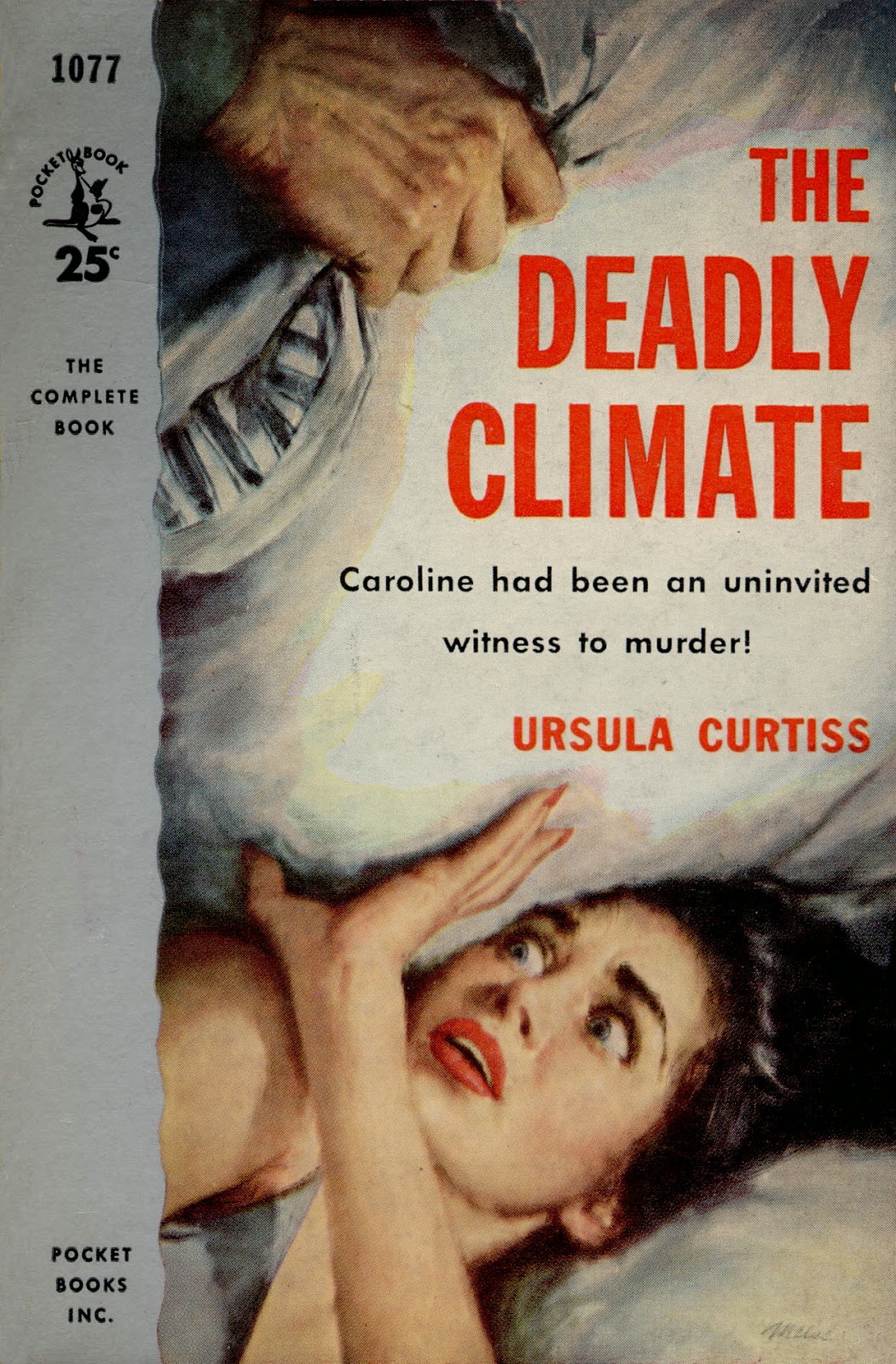
I was fairly unfamiliar with author Ursula Curtiss (1923-1984) until this year, but I’ve now showcased two of her novel fronts in the last two months. The first came from Out of the Dark (1964), which I incorporated into Killer Covers’ sixth-anniversary succession of posts last month. And now we have The Deadly Climate, carrying a dramatic illustration by James Meese and published in paperback by Pocket Books in 1955. It’s a work I thought of recently while reading about how Republicans in the U.S. Congress--often derided for being “at war with science”--sought, in quite farcical fashion, to acknowledge the existence of climate change, while simultaneously denying that human activity contributes to such dangerous environmental developments.
A daughter of Golden Age police procedural writer Helen Reilly, Curtiss penned almost two dozen mystery and suspense novels over her 36-year-long career. I believe The Deadly Climate was her fifth book, released originally by Dodd, Mead & Company in 1954. Writing about this novel last fall in Pretty Sinister Books, John Norris delivered the following synopsis of Curtiss’ tale:
Caroline Emmett has been sent to a rest home in Wicklow, Massachusetts, upon orders from her doctor. There she will recuperate from pneumonia and mental duress following her discovery of her husband’s dallying with a woman half his age. Walking in the countryside she finds to be more therapeutic than any treatment from her nurses and doctors at the rest home. One evening she takes a detour from her regular path and climbs up a hill. She witnesses the brutal beating of a woman at the hands of a bulky figure wearing a man’s raincoat. Or so she thinks. He shines his flashlight on her, leaving it there for several minutes, and Caroline flees. Bad weather--rain and wind--force her to seek shelter before she can return to her room. She manages to gain entry to the home of the Olivers, where she tells her story while they listen with a mixture of disbelief and curiosity. She’ll remain here for the next twelve hours while the killer in the raincoat tracks her down.Curtiss’ novel obviously has naught to do with ideology-driven right-wing efforts to separate the modern warming of Earth’s atmosphere from the deleterious behavior of big industries and other human endeavors. Yet when I look at that pillow being pressed down toward the woman’s face in Meese’s painting, I can’t help but imagine a time when our climate might similarly threaten all of humankind, unless short-sighted, science-eschewing politicians stop discounting the existence of environmental change and start trying to reduce its potentially disastrous effects.
This is familiar territory, to be sure--the eyewitness to a crime who seems to have imagined everything. Of course no body is found where Caroline said she saw the attack. But don’t expect the story to fall into the trap of a well-worn formula and an obvious unfolding of events. Enter Carmichael, the editor and owner of the local newspaper, with a nose for news and a healthy dose of common sense. He is the only one who believes Caroline. With the permission of a lackadaisical and skeptical policeman named Trunz the newsman heads out to the crime site to do some real work. He quickly finds two sets of footprints in the mud and a woman’s patent leather shoe. Size 9. Something bad has happened he is sure. And he begins his dogged search for the woman with one shoe. Or her dead body.
FOLLOW-UP: It appears the James Meese cover art from The Deadly Climate was later used (though it was flopped) on the cover of the April 1961 edition of Mike Shayne Mystery Magazine.
READ MORE: “Friday’s ‘Forgotten” Books—Voice Out of Darkness,” by B.V. Lawson (In Reference to Murder).





No comments:
Post a Comment